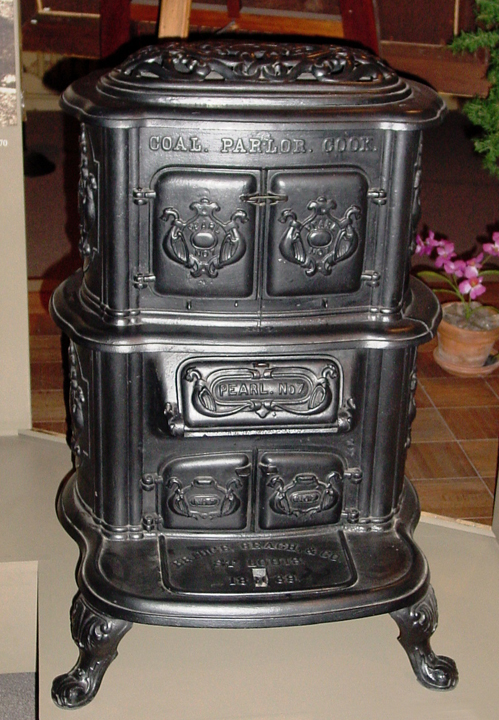
JEFF 4750-Bridge Beach and Company, Model #7 Pearl-Cast Iron Parlor Stove
Among the early industries in St. Louis, the manufacture of stoves emerged as one of the largest and most successful. The ever growing market for stoves in the West coupled with the abundance of iron from the area made stove manufacturing one of the city's most significant and lasting industries.. In the slightly more than 100 years that it existed, St. Louis led much of the country in stove manufacturing. A fine example of a cast iron stove in our collection is JEFF 4750-an 1869 cast iron parlor stove by Bridge, Beach and Company, Model #7 The Pearl.
The featured stove was designed for both providing heat and for cooking purposes. The top doors gave a glowing heat to the parlor while above them were two openings where a coffee pot and a skillet could be used (by removing the ornamental top). The stove is cast iron with an ornamental design that resembles a coat-of-arms type pattern. This design is on both sides and on each front door. At top, in the front, reads in a raised pattern, "Coal Parlor, Cook." On the doors reads "Pearl No. 7." On top of the ash pit door reads, "Bridge, Beach, and Co./St. Louis/1869." The stove has 4 ornamental legs.
The founder of the company that made this stove was Hudson E. Bridge. He was born in New Hampshire and ended up at the age of 28 in St. Louis starting his own business. In 1837, he opened a store for the retail sale of stoves, which at that time, were brought in by steamboat or barge. He believed it would be less expensive to manufacture his own iron plates on site. In 1838, he opened his foundry and established the Empire Stove Works which was destined to become one of the largest and best-known manufacturing enterprises of the Mississippi Valley. The name of the company changed in 1842 to Bridge and Brother when his brother Harrison became part owner. His brother's death in 1850 left him operating the business alone for several years. In 1857, John H. Beach, who had been connected to the firm for many years, became an associate, thus changing the name of the company to Bridge, Beach, and Company.
There were other entrepreneurs who became successful in the stove making business in St. Louis. Charles H. Buck and Wiley S. Wright founded the Eclipse Stove works and created the popular Buck cooking stove. One of the most successful operations in St. Louis was the Giles F. Fillley's Excelsior Stove Works. They patented the "Charter Oak" stove. These were the pioneers in the early stove making business in St. Louis. Throughout the rest of the 19th century, a number of stove manufacturers were active and prosperous. However, the way people cooked their meals and heated their homes changed in the 20th century. Gas stoves and hot air furnaces replaced wood burning stoves. Thus, many of these companies disappeared.
These early stove makers were part of westward expansion in providing a necessity for pioneers heading west to start a new life. The industry provided jobs and economic prosperity and helped in the growth of St. Louis's industrial development.
